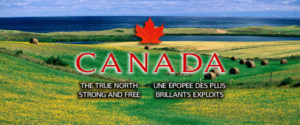
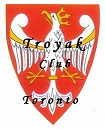
TROYAK EXECUTIVE TEAM is informing all members, colleagues, collectors, and Polonia at large, that Club meetings taking place at John Paul II Polish Cultural Centre, 4300 Cawthra Rd. (just south of Hwy. 403), Mississauga, Ontario. The new members are always welcome. www.polishculturalcentre.ca
ADRES SPOTKAÑ KLUBOWYCH ! Zarząd Główny Klubu “Troyak” informuje wszystkich członków kolekcjonerów, sympatyków oraz całą Polonię, że spotkania klubowe odbywają się w Polskim Centrum Kultury im. Jana Pawła II, przy 4300 Cawthra Rd. (na południe od autostrady 403), Mississauga, Ontario. Zapraszamy nowych członków do prężnego. Klubu “Troyak”. www.polishculturalcentre.ca

“TROYAK” CLUB NEXT MEETINGS …
NASTĘPNE SPOTKANIA KLUBU “TROYAK” …

TROYAK CLUB @ Roncesvalles Polish Festival 2022

Saturday, 17th September 2022 … Festival Hours: 11:00am to 11:00pm
Sunday, 18th September 2022 … Festival Hours: 11:00am to 7:00pm
https://polishfestival.ca www.kazimierz.org
St. Casimir’s Church
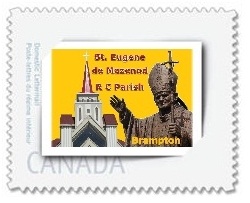
Parish Hall … 156 Roncesvalles Ave. Toronto, Ontario
Stamp Exhibit … Pope John Paul II on World Stamps and
Displays of Coins, Stamps, Collectibles by Troyak Club Members.
Roncesvalles Polish Festival
https://polishfestival.ca
www.kazimierz.org
www.troyakclub.com

Sunday 25th September 2022 @ 4:30 p.m.
Sunday – 2nd October 2022 @ 9:00 a.m. to 4:00 p.m.
Mississauga Coin & Stamp Show
30th October 2022
27th November 2022
December 2022 … Happy Holidays!


Roncesvalles Polish Festival 2022
https://polishfestival.ca
Roncesvalles Festival, North America’s largest celebration of Polish culture in Toronto’s best neighbourhood, Roncesvalles Village! We look forward to seeing you in September 2022. Now entering its fifteenth year, the Roncesvalles Polish Festival adds an old world charm to today’s Roncesvalles Village, well-known as one of Toronto’s most vibrant, diverse and creative communities.
Enjoy great local and international music, including Polish folklore, Polka and Euro dance bands, and entertainment from near and far on multiple stages. Saturday night enjoy the ever-popular Dance Under The Stars. Come out and sample fantastic cuisine from over 40 renowned restaurants, cafes, bakeries, and bistros, along Roncesvalles, and of course, lots of traditional Polish fare, including pierogi, kielbasa, bigos, cabbage rolls, and much much more!

Discover treasures along the 18 blocks of boutique shops and merchants. We also have a Car Show and many great vendors with unique products and food. The Roncesvalles Festival is easy to get to by transit and car, family-friendly and free, with lots of entertainment for kids, families, and adults, including two midway areas, three stages with continuous entertainment, two giant beverage gardens, and of course the wonderful offerings of Roncesvalles Village’s restaurants and merchants.
The Legislative Assembly of Ontario established month May as the Polish Heritage Month in Ontario. So called Bill 18 was introduced as a private bill by MPP Christine Hogarth. The bill received Royal Assent on December 9, 2021 by The Honourable Elizabeth Dowdeswell.
Ontario is home for over than half million people with Polish heritage. The Polish community is one of the most numerous groups in Ontario. This great group of Canadians of Polish origin has been participating in building Canada for generations to enrich its culture and heritage and become integral part of its multicultural community. Poles raise their children as part of the Canadian community and with respect to its values. Most of the Canadian families with Polish origin want to raise their descendants also in acquaintance with the language, culture and traditions of the country of their ancestors. By proclaiming the month of May as Polish Heritage Month, the Province of Ontario recognized great impact that Polish Canadians have had on Ontario’s history, culture and community.

Polish Heritage Month will be celebrated each May, commemorating Constitution Day in Poland – the implementation of the first democratic and progressive constitution in Europe on May 3rd, 1791. This is one of the most important dates in Poland’s history and marks the centuries log struggle for freedom and independence by the Polish people. Polish Heritage Month is an opportunity to bring closer to Ontarians of all ages and backgrounds Polish history and traditions. Ontario is a proud region of many cultures and proclaiming May as Polish Heritage Month is reflecting core values of its habitants.


Miasta Polskie – Lubliniec
Polish cities – Lubliniec
www.poczta-polska.pl
W dniu 17 czerwca 2022 został wprowadzony do obiegu znaczek pocztowy o wartości odpowiadającej opłacie za list ekonomiczny krajowy w formacie S emisji “Miasta Polskie – Lubliniec”. Na znaczku przedstawiono fragment fontanny z rzeźbą małej dziewczynki na cześć Edyty Stein – patronki miasta. Edyta Stein jako mała dziewczynka bywała u swoich dziadków, których dom znajdował się i znajduje w Lublińcu. Obecnie jest w nim Muzeum Pro Memoria Edith Stein. Na znaczku jest także kościół pw. Św. Mikołaja, najstarszy kościół w Lublińcu; i napis: LUBLINIEC. Wzdłuż dolnej krawędzi umieszczono napis: POLSKA i oznaczenie: EKONOMICZNY S, co odpowiada wartości nominalnej znaczka pocztowego właściwego do uiszczenia opłaty za ekonomiczną przesyłkę listową nierejestrowaną w obrocie krajowym w formacie S i ekonomiczną kartkę pocztową w obrocie krajowym. Na kopercie: zdjęcie Zamku w Lublińcu autorstwa Daniela Dmitriewa Datownik: wizerunek św. Jana Nepomucena wg. XVIII-to wiecznej barokowej figury, która stoi na rynku w Lublińcu. Znaczek wydrukowano techniką rotograwiurową, na papierze fluorescencyjnym w formacie 25,5 x 31,25 mm, w nakładzie 2 000 000 szt, powtarzalnym. Arkusz sprzedażny zawiera 100 znaczków. Z tej okazji została wydana również koperta FDC. Autor projektu: Andrzej Gosik.
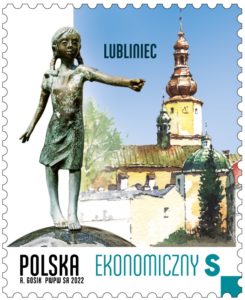
Polish cities – Lubliniec … denomination: 3,60 PLN; number of stamps in set: 1 (100 pcs in sheet); print run: 2 000 000 pcs.; printing techniques: photogravure; paper: fluorescent; stamp size: : 25,5 x 31,25 mm; number of FDC: 1; author: Andrzej Gosik; circulation date: 17th June 2022.
Lubliniec to jedno z najstarszych miast Śląska. Ośrodek został założony na szlaku handlowym z Wrocławia do Krakowa w 1270 roku przez księcia Władysława Opolskiego. Prawa miejskie Lubliniec uzyskał w 1272 roku i w tym też roku rozpoczęła się budowa miejskiego ratusza oraz kościoła pw. św. Mikołaja. Do tej pory w ramach serii obiegowej „Miasta polskie” Poczta Polska zaprezentowała Gniezno, Kraków, Warszawę, Kalisz, Płock, Toruń, Pułtusk (na kopercie z nadrukowanym znakiem opłaty pocztowej), Kazimierz Dolny, Sandomierz, Gdańsk, Łódź (z przywieszką Priorytet), Poznań, Przemyśl, Szczecin, Sopot, Sieradz, Katowice, Częstochowę, Gorzów Wlkp., Chorzów, Racibórz, Jelenią Górę, Nowy Sącz, Żywiec, Białystok, Leszno, Bydgoszcz i Mińsk Mazowiecki. Cykl zapoczątkował artysta grafik Andrzej Gosik, korzystając z techniki akwarelowej. Maria Dziekańska zaprojektowała znaczki prezentujące Szczecin, Sopot, Sieradz, Katowice i Częstochowę, Jerzy Pietras – Gorzów Wlkp., a Monika Żyła-Kwiatkowska – Chorzów.

100. Rocznica powrotu Górnego Śląska do Polski
100th Anniversary of the return of Upper Silesia to Poland
www.poczta-polska.pl
W dniu 20 czerwca 2022 roku został wprowadzony do obiegu znaczek pocztowy o wartości 3,60 zł emisji “100. rocznica powrotu Górnego Śląska do Polski”. Na znaczku przedstawiono historyczny moment wkroczenia wojsk polskich na Śląsk 22.06.1922 roku i powitanie gen. Stanisława Szeptyckiego na Rynku w Katowicach. Na kopercie: wkroczenie wojsk polskich na Śląsk 22.06.1922 r. – powitanie w Katowicach; oddział ułanów na ulicach oraz wzór orła śląskiego 74 Górnośląskiego Pułku Piechoty. Znaczki wydrukowano techniką offsetową, na papierze fluorescencyjnym, w formacie 31,25 x 43 mm, w nakładzie 144 000 sztuk. Arkusz sprzedażny zawiera 12 sztuk znaczków. Z tej okazji została wydana również koperta FDC. Autor projektu: Adam Kultys.

100th Anniversary of the return of Upper Silesia to Poland …
denomination: 3,60 PLN; number of stamps in set: 1;
12 stamps in sheet; print run: 144.000 pcs;
printing technique: offset; stamp size: 31,25 x 43 mm;
number of FDC: 1; author: Adam Kultys;
circulation date: 20th June 2022.


Polskie uzdrowiska
Polish spas
www.poczta-polska.pl
Dnia 21 czerwca 2022 r. zostały wprowadzone do obiegu dwie kartki pocztowe z nadrukowanym znakiem opłaty pocztowej, emisji: Polskie uzdrowiska. Wartość nominalna znaku opłaty pocztowej z oznaczeniem literowym A odpowiada wartości nominalnej znaczka pocztowego używanego do uiszczenia opłaty za ekonomiczną przesyłkę listową nierejestrowaną, w tym kartkę pocztową, w obrocie krajowym, w formacie S. Na kartkach pocztowych przedstawiono: ***1) na pierwszej – fotografię Parku Zdrojowego w Połczynie-Zdroju. Wzdłuż dolnej krawędzi znaczka umieszczono napis: POLSKA i oznaczenie wartości: A; ***2) na drugiej – fotografię Pijalni Wód Mineralnych w Szczawnie-Zdroju. Wzdłuż górnej krawędzi znaczka umieszczono napis: POLSKA, a w dolnym prawym rogu oznaczenie wartości: A.

W częściach ilustracyjnych kartek przedstawiono: ***1) na pierwszej – herb miasta Połczyn-Zdrój i logo Szwajcarii Połczyńskiej oraz fotografie przedstawiające Szwajcarię Połczyńską, Tężnię Solankową oraz fontannę ,,Grajek”, w środkowej części umieszczono napis ,,Polskie uzdrowiska Połczyn-Zdrój”, a poniżej naczynie do picia wody mineralnej, stojące na kręgach wody; ***2) na drugiej – herb miasta Szczawno-Zdrój oraz fotografie przedstawiające Dom Zdrojowy oraz Pijalnię Wód Mineralnych, w środkowej części umieszczono napis ,,Polskie uzdrowiska Szczawno-Zdrój”, a poniżej naczynie do picia wody mineralnej, stojące na kręgach wody. Emisja realizowana przy współpracy oraz na bazie materiałów otrzymanych z Gminy w Połczynie-Zdroju oraz Gminy w Szczawnie-Zdroju. Kartki o wymiarach 148 x 105 mm wydrukowano jednostronnie, techniką offsetową, na kartonie białym, w nakładzie 5000 sztuk. Autor projektu kartek: Agnieszka Sancewicz.
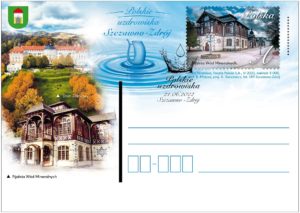
Polish spas … denomination: 3,60 PLN;
number of stationeries in set: 2;
print run: 5.000 pcs; printing technique: offset;
card size: 148 x 105 mm; author: Agnieszka Sancewicz;
release date: 21st June 2022.

Sztuka sakralna
Sacred art
www.poczta-polska.pl
W dniu 22 czerwca 2022 r. została wprowadzona do obiegu kartka pocztowa z nadrukowanym znakiem opłaty pocztowej, emisji: Sztuka sakralna. Wartość nominalna znaku opłaty pocztowej z oznaczeniem literowym A odpowiada wartości nominalnej znaczka pocztowego używanego do uiszczenia opłaty za ekonomiczną przesyłkę listową nierejestrowaną, w tym kartkę pocztową, w obrocie krajowym, w formacie S. W prawym górnym rogu strony adresowej kartki nadrukowano znak opłaty pocztowej, na którym na pierwszym planie przedstawiono Jana Długosza, fundatora Klasztoru OO. Paulinów w Krakowie na tle fragmentu obrazu: Budowa kościoła gotyckiego w XV wieku i sprowadzenie Paulinów w 1472 roku autorstwa Joanny Magoch. Wzdłuż dolnej krawędzi znaczka umieszczono napis: POLSKA oraz oznaczenie wartości: A. W części ilustracyjnej kartki umieszczono widok barokowego kościoła na Skałce w Krakowie z XVIII wieku oraz logo obchodów 550-lecia obecności Paulinów na Skałce. Kartkę o wymiarach 148 x 105 mm wydrukowano jednostronnie, techniką offsetową, na kartonie białym, w nakładzie 5000 sztuk. Autor projektu kartki: Jacek Konarzewski.
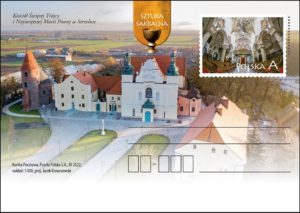
Sacred art … denomination: 3,60 PLN
number of stationeries in set: 1
print run: 5.000 pcs; printing technique: offset;
card size: 148 x 105 mm; author: Jacek Konarzewski;
release date: 22nd June 2022.

125. Rocznica urodzin Henryka Dobrzańskiego ps. Hubal
125th Anniversary of the Birth of Henryk Dobrzański alias Hubal
www.poczta-polska.pl
W dniu 22 czerwca 2022 r. został wprowadzony do obiegu znaczek pocztowy o wartości 3,60 zł emisji “125. rocznica urodzin Henryka Dobrzańskiego ps. Hubal”. Na znaczku przedstawiono portret Henryka Dobrzańskiego ps. Hubal – majora kawalerii Wojska Polskiego, sportowca, ostatniego polskiego ,,zagończyka” – dowódcę Oddziału Wydzielonego Wojska Polskiego w czasie II wojny światowej. Na kopercie FDC widnieje archiwalna fotografia, na której znajduje się mjr Henryk Dobrzański ps. Hubal (w środku, z jasnym szalikiem zarzuconym na mundur) w otoczeniu grupy żołnierzy Oddziału Wydzielonego Wojska Polskiego. Zdjęcie wykonano w okolicy miejscowości Gałki Krzczonowskie w lutym 1940 r. Na datowniku umieszczono podpis H. Dobrzańskiego. Znaczek wydrukowano techniką offsetową , na papierze fluorescencyjnym, w formacie znaczka 31,25 x 43 mm, w nakładzie 168.000 sztuk. Arkusz zawiera 12 znaczków (3×4) w układzie tete-beche. Z tej okazji została wydana również koperta FDC. Autor projektu znaczka: Poczta Polska S.A. Koloryzacja fotografii: Mirosław Szponar.
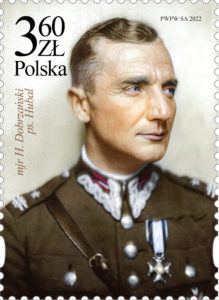
125th Anniversary of the Birth of Henryk Dobrzański alias Hubal … denomination: 3,60 PLN; number of stamps in set: 1; print run: 168.000 pcs.; printing techniques: offset; paper: fluorescent; stamp size: 31,25 x 43 mm; 12 stamps in sheet; number of FDC: 1; author: Poczta Polska S.A.; photographic colorization: Mirosław Szponar; circulation date: 22nd June 2022.


1050. Rocznica bitwy pod Cedynią
1050th Anniversary of the Battle of Cedynia
www.poczta-polska.pl
W dniu 24 czerwca 2022 roku został wprowadzony do obiegu znaczek pocztowy o wartości 3,60 zł emisji “1050. rocznica bitwy pod Cedynią”. Na znaczku przedstawiono fragment mozaiki spod Góry Czcibora przedstawiający wyobrażenie bitwy pod Cedynią i napis: 1050. ROCZNICA BITWY POD CEDYNIĄ. Z tej okazji została wydana koperta FDC, na której przedstawiono również fragment mozaiki spod Góry Czcibora przedstawiający wyobrażenie bitwy pod Cedynią. Znaczki wydrukowano techniką offsetową, na papierze fluorescencyjnym, w formacie 31,25 x 43 mm, w nakładzie 168 000 sztuk. Arkusz sprzedażny zawiera 12 sztuk znaczków. Autor projektu: Jarosław Ochendzan.
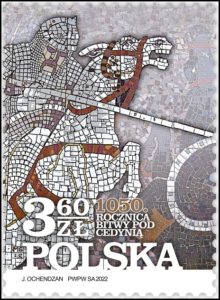
1050th Anniversary of the Battle of Cedynia …
denomination: 3,60 PLN; number of stamps in set: 1;
12 stamps in sheet; print run: 168.000 pcs;
printing technique: offset; stamp size: 31,25 x 43 mm;
number of FDC: 1; author: Jarosław Ochendzan;
circulation date: 24th June 2022.

200 lat Ballad i romansów Adama Mickiewicza
200 Years of Ballads and Romances by Adam Mickiewicz
www.poczta-polska.pl
W dniu 25 czerwca 2022 r. została wprowadzona do obiegu kartka pocztowa z nadrukowanym znakiem opłaty pocztowej, emisji: 200 lat “Ballad i romansów” Adama Mickiewicza. Wartość nominalna znaku opłaty pocztowej z oznaczeniem literowym A odpowiada wartości nominalnej znaczka pocztowego używanego do uiszczenia opłaty za ekonomiczną przesyłkę listową nierejestrowaną, w tym kartkę pocztową, w obrocie krajowym, w formacie S. Na znaku opłaty pocztowej umieszczono fragment strony tytułowej pierwszego wydania tomu ,,POEZYE” Adama Mickiewicza, wydanego w Wilnie w 1822 roku, który zawierał m. in. ,,Ballady i romanse”. W części ilustracyjnej kartki umieszczono tytuł emisji oraz portret Adama Mickiewicza, również pochodzący z wspomnianego pierwszego wydania tomu ,,Poezye” oraz ,również stamtąd podchodzące, zapisane oryginalną czcionką, tytuł rozdziału ,,BALLADY I ROMANSE.” i cytat: ,,Miej serce i patrzaj w serce!”. Kartkę o wymiarach 148 x 105 mm wydrukowano jednostronnie, techniką offsetową, na kartonie białym, w nakładzie 5000 sztuk. Autor projektu kartki: Jan Konarzewski.

200 Years of Ballads and Romances by Adam Mickiewicz…
denomination: 3,60 PLN; number of stationeries in set: 1;
print run: 5.000 pcs; printing technique: offset;
card size: 148 x 105 mm; author: Jan Konarzewski;
release date: 25th June 2022.

Polska Zobacz Więcej
Poland See More
www.poczta-polska.pl
W dniu 28 czerwca 2022 zostały wprowadzone do obiegu 2 znaczki pocztowe o wartości 3,60 zł każdy emisji “Polska Zobacz Więcej”. Znaczki serii “Polska zobacz więcej” wydawane są od 2018 roku, kiedy to 2 znaczki autorstwa śp. Marzanny Dąbrowskiej zostały dedykowane pięknu Wybrzeża Morza Bałtyckiego oraz Kopalni Soli w Wieliczce. Kolejne 2 znaczki tej serii autorstwa śp. Marzanny ukazały się w 2020 roku i były poświęcone pięknu Biebrzańskiego Parku Parku Narodowego oraz Geoparku Łuk Mużakowa. Prezentowane obecnie wydanie serii “Polska zobacz więcej ” autorstwa Pana Rocha Stefaniaka zawiera logotyp emisji w oprawie arkusza stworzony przez śp. Marzannę Dąbrowską. Na pierwszym znaczku przedstawiono widok Ratusza i Rynku Wielkiego w Zamościu, a na drugim znaczku przedstawiono widok Zamku Czocha.
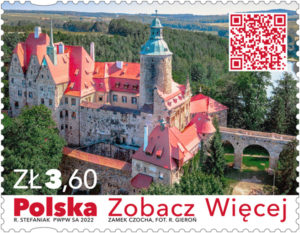
Na znaczkach, tak jak w poprzednich wydaniach tej serii, umieszczono kody QR z filmikami promującymi prezentowane miejsca. Emisji znaczków towarzyszą 2 koperty FDC (jeden wzór) oraz 2 datowniki będące kontynuacją wzorów datowników stosowanych w tej serii w poprzednich latach i zawierających logotyp emisji “Polska zobacz więcej”. Znaczki wydrukowano techniką offsetową, na papierze fluorescencyjnym, format znaczków: 51 x 39,5 mm , w nakładzie 120.000 szt. każdego. Arkusz sprzedażny zawiera 8 szt. znaczków. Autor projektu: Roch Stefaniak.
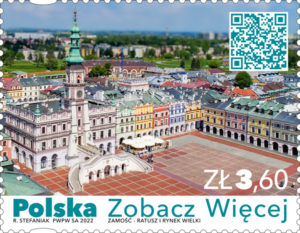
Poland See More … denomination: 3,60 PLN of each;
number of stamps in set: 2; printing techniques: offset;
print run: 120.000 pcs. of each; paper: fluorescent;
stamp size: 51 x 39,5 mm; 8 stamps in sheet;
number of FDC: 2; author: Roch Stefaniak;
circulation date: 28th June 2022.

100-lecie Polskiego Towarzystwa Botanicznego
100th Anniversary of the Polish Botanical Society
www.poczta-polska.pl
W dniu 28 czerwca 2022 r. została wprowadzona do obiegu kartka pocztowa z nadrukowanym znakiem opłaty pocztowej, emisji: 100-lecie Polskiego Towarzystwa Botanicznego. Wartość nominalna znaku opłaty pocztowej z oznaczeniem literowym A odpowiada wartości nominalnej znaczka pocztowego używanego do uiszczenia opłaty za ekonomiczną przesyłkę listową nierejestrowaną, w tym kartkę pocztową, w obrocie krajowym, w formacie S. W polu znaku opłaty pocztowej umieszczono zdjęcie Pleszczotki Wóycickiego na hałdzie galmanowej. Wzdłuż górnej krawędzi znaczka umieszczono napis: POLSKA oraz oznaczenie wartości: A.
W projekcie kartki w części ilustracyjnej umieszczono tytuł emisji ,,100-lecie Polskiego Towarzystwa Botanicznego” oraz rysunek przedstawiający zbliżenie owoców i kwiatów Pleszczotki Wóycickiego (Biscutella laevigata subsp. wóycicki) – rośliny występującej na hałdach zanieczyszczonych metalami ciężkimi. W 2020 r. roślina ta została nazwana na cześć prof. Z. Wóycickiego, jednego z założycieli Polskiego Towarzystwa Botanicznego. Kartka została zaprojektowana w ścisłej współpracy z Polskim Towarzystwem Botanicznym. Kartkę o wymiarach 148 x 105 mm wydrukowano jednostronnie, techniką offsetową, na kartonie białym, w nakładzie 5000 sztuk. Autor projektu kartki: Paweł Myszka.
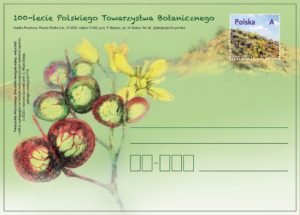
100th Anniversary of the Polish Botanical Society … denomination: 3,60 PLN; number of stationeries in set: 1; print run: 5.000 pcs; printing technique: offset; card size: 148 x 105 mm; author: Paweł Myszka; release date: 28th June 2022.

30-lecie polsko-słoweńskich stosunków dyplomatycznych
30th Anniversary of Polish-Slovenian Diplomatic Relations
www.poczta-polska.pl
W dniu 29 czerwca 2022 r. została wprowadzona do obiegu kartka pocztowa z nadrukowanym znakiem opłaty pocztowej, emisji: 30-lecie polsko-słoweńskich stosunków dyplomatycznych. Wartość nominalna znaku opłaty pocztowej z oznaczeniem literowym A odpowiada wartości nominalnej znaczka pocztowego używanego do uiszczenia opłaty za ekonomiczną przesyłkę listową nierejestrowaną, w tym kartkę pocztową, w obrocie krajowym, w formacie S. W polu znaku opłaty pocztowej umieszczono fragment widoku na historyczną część Lublany – stolicy Słowenii. Wzdłuż dolnej krawędzi znaczka umieszczono napis: POLSKA, a w prawej dolnej części oznaczenie wartości: A. W części ilustracyjnej kartki po lewej stronie znajduje się zdjęcie współczesnej części Warszawy, a po prawej widok na historyczną część Lublany. W centralnej części projektu znajdują się flagi Polski i Słowenii, wpisane w połączone ze sobą puzzle. Kartkę o wymiarach 148 x 105 mm wydrukowano jednostronnie, techniką offsetową, na kartonie białym, w nakładzie 5000 sztuk. Autor projektu kartki: Poczta Polska S.A.
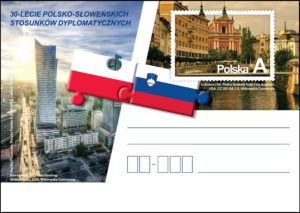
30th Anniversary of Polish-Slovenian Diplomatic Relations … denomination: 3,60 PLN; number of stationeries in set: 1; print run: 5.000 pcs; printing technique: offset; card size: 148 x 105 mm; author: Poczta Polska S.A.; release date: 29th June 2022.

Utracone skarby architektury
Lost architectural treasures
www.poczta-polska.pl
W dniu 30 czerwca 2022 zostały wprowadzone do obiegu 2 znaczki pocztowe o wartości 3,60 zł każdy emisji “Utracone skarby architektury”. Wydając serię „Utracone skarby architektury” Poczta Polska chce pokazać na znaczkach dzieła związane z dziedzictwem kulturowym i historycznym Polski, promując także rewitalizację najbardziej cennych obiektów w Polsce. Na pierwszym znaczku przedstawiono rycinę Zamku w Pińczowie. Wzdłuż dolnego brzegu znaczka umieszczono napis: Polska, Utracone skarby architektury oraz Zamek Myszkowskich w Pińczowie, ryc. wg rys. E. Dahlbergha, 1696. Na drugim znaczku przedstawiono rycinę Pałacu Saskiego. Wzdłuż dolnego brzegu znaczka umieszczono napis: Polska, Utracone skarby architektury oraz Pałac Saski, ryc. wg rys. P. Ricaud de Tirregaillea, 1762. W zamyśle twórcy oba znaczki miały zaprezentować historyczne budowle z czasów ich świetności jeszcze przed przebudową. Jednocześnie są to jedyne dostępne obecnie wizerunki obu obiektów, które zachowały się do dziś. Emisja powstała w ścisłej współpracy z Muzeum Regionalnym w Pińczowie oraz ze spółką Pałac Saski. Znaczki wydrukowano techniką offsetową, na papierze fluorescencyjnym, format znaczków: 43 x 31,25 mm, w nakładzie 180.000 szt. każdego. Arkusz sprzedażny zawiera 8 szt. znaczków. Autor projektu: Jarosław Ochendzan.
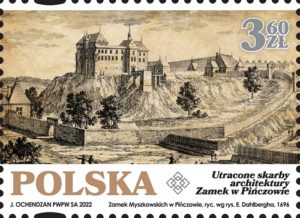
Lost architectural treasures … denomination: 3,60 PLN of each;
number of stamps in set: 2; print run: 180.000 pcs. of each;
printing techniques: offset; paper: fluorescent;
stamp size: 43 x 31,25 mm; 8 stamps in sheet;
number of FDC: 2; author: Jarosław Ochendzan;
circulation date:30th June 2022.
Zespół Zamkowy w Pińczowie, w XV w. był najwspanialszą siedzibą możnowładczą w Małopolsce. Charakteryzował się wyjątkową architekturą, jego przebudowę prowadził Santi Gucci, architekt i nadworny rzeźbiarz Anny Jagiellonki oraz Stefana Batorego. Zamek w Pińczowie przestał istnieć pod koniec XVIII w.

Pałac Saski przetrwał w Warszawie prawie 300 lat, ale zmieniał się kilkukrotnie aż został wysadzony w powietrze w 1944 roku przez niemieckiego okupanta. Jedyny ocalały fragment Pałacu Saskiego to Grób Nieznanego Żołnierza. Pałac powstał w drugiej połowie XVII w. Jan Andrzej Morsztyn, wówczas polityk, obecnie znany jako poeta, uzyskał od króla pozwolenie na budowę barokowego pałacu. Gmach zaprojektował albo Tylman z Gameren, albo architekt Wazów Giovanni Battista Gisleni. W 1713 roku córka Morsztyna sprzedała posiadłość Augustowi II Mocnemu, który podjął się gruntownej przebudowy pałacu, pragnąc stworzyć królewską rezydencję na wzór Wersalu z reprezentacyjnym placem i wspaniałym ogrodem. Pałac, nazwany został wówczas Saskim. Był centralnym ogniwem założenia urbanistycznego zwanego Osią Saską. Rozbudowę kompleksu kontynuował syn władcy, następca tronu August III Sas. Okres panowania Augusta III to lata świetności Pałacu Saskiego, do którego przyłączono sąsiadujący z nim Pałac Brühla i rezydencję biskupa Potockiego. Złota epoka skończyła się jednak w roku śmierci króla w 1763 roku. W 1837 roku Pałac Saski kupił Rosjanin Jan Skwarcow, który zlecił gruntowną przebudowę. Powstał gmach w stylu klasycystycznym, projektu Adama Idźkowskiego, który stworzył Pałac Saski w najbardziej znanym kształcie – w miejscu środkowej części kompleksu umieścił charakterystyczną kolumnadę w stylu korynckim.


100. Rocznica powrotu części Górnego Śląska do Polski
www.nbp.pl
Narodowy Bank Polski jest centralnym bankiem państwa odpowiadającym za politykę pieniężną i stabilność cen. Jego funkcje określa Konstytucja Rzeczypospolitej Polskiej i ustawa o NBP. NBP ma wyłączne prawo emisji pieniądza. Jako bank centralny nie prowadzi rachunków bankowych obywateli, nie przyjmuje od nich lokat, nie udziela kredytów. Prowadzi natomiast obsługę budżetu państwa, a także podmiotów sektora finansów publicznych. Gromadzi rezerwy walutowe państwa i zarządza nimi. Pełni funkcję banku banków, tworząc warunki do działania systemu bankowego. Jest również jednym z najważniejszych ośrodków naukowo-analitycznych w dziedzinie ekonomii i rynków finansowych.
Emisja wartości kolekcjonerskich stanowi okazję do upamiętniania ważnych historycznych rocznic i postaci oraz do rozwijania zainteresowań polską kulturą, nauką i tradycją. 9 czerwca 2022 roku Narodowy Bank Polski wprowadził do obiegu srebrną monetę o nominale 10 zł „100. rocznica powrotu części Górnego Śląska do Polski”.
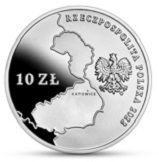
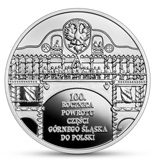
Nominał 10 zł … metal: Ag 925/1000; stempel: lustrzany; średnica: 32,00 mm; masa: 14,14 g; brzeg (bok): gładki; nakład: do 10 000 szt.; Projektant: Dominika Karpińska-Kopiec; Emitent: NBP; Na zlecenie NBP monety wyprodukowała Mennica Polska S.A.
Rewers monety przedstawia bramę triumfalną w Królewskiej Hucie (dzisiejszym Chorzowie) przygotowaną na przyjęcie Wojska Polskiego (23 czerwca 1922 roku). Brama została zbudowana przez powstańca śląskiego Antoniego Kopiecznego. Nad głównym łukiem są widoczne inicjały Wojciecha Korfantego i Józefa Piłsudskiego oraz symbole górnicze i hutnicze. Na awersie monety odwzorowano granice Górnego Śląska, który w wyniku decyzji Rady Ligi Narodów i Rady Ambasadorów w październiku 1921 roku stał się częścią II Rzeczypospolitej Polskiej.
5 lipca 1921 roku, po kilkudniowych negocjacjach, zawarto rozejm kończący jeden ze zwycięskich zrywów narodowych – III powstanie śląskie. Rozpoczęły się kolejne, długie rozmowy w sprawie przebiegu granic i dopiero w październiku 1921 roku decyzją Rady Ligi Narodów i Rady Ambasadorów doszło do finalnego podziału spornego terenu między Polską a Niemcami. Polska otrzymała mniejszy terytorialnie obszar, ale bardziej uprzemysłowiony, w tym mniej więcej połowę hut i dwie trzecie kopalń górnośląskich. 15 czerwca 1922 roku Komisja Międzysojusznicza poinformowała rządy Polski i Niemiec, że w ciągu miesiąca państwa powinny objąć przyznane im terytoria Górnego Śląska. Strony konfliktu dokonywały tego w kilku etapach. Na rynku w Katowicach odbyła się parada wchodzących w skład wojsk alianckich oddziałów francuskich i ich wymarsz z Katowic.
Po wycofaniu oddziałów sił sprzymierzonych 20 czerwca 1922 roku na przyznane Polsce terytoria weszły wojska polskie pod dowództwem gen. Stanisława Szeptyckiego. Przekroczyły one most graniczny w Szopienicach (dziś dzielnicy Katowic) witane licznie przez Ślązaków na czele z dyktatorem powstańczym Wojciechem Korfantym i wojewodą śląskim Józefem Rymerem. Następnie oddziały polskie doszły do katowickiego rynku, gdzie witały je tłumy. Po drodze mieszkańcy ustawili blisko 30 odświętnie udekorowanych bram powitalnych. W następnych dniach entuzjastycznie przyjmowane wojska polskie zajmowały kolejne miejscowości. W sumie w regionie zbudowano ponad 200 – często imponujących – triumfalnych bram. 16 lipca 1922 roku uroczyście podpisano w Katowicach Akt objęcia Górnego Śląska przez Rząd Rzeczypospolitej Polskiej. Na terenach tych powstało autonomiczne województwo śląskie ze stolicą w Katowicach. Znajdujący się na Górnym Śląsku przemysł oraz kapitał odegrał bardzo ważną rolę w odbudowie gospodarczej II Rzeczypospolitej. Informacja: prof. dr hab. Zygmunt Woźniczka.

100th Anniversary of the Return of a Part
of Upper Silesia to Poland
www.nbp.pl
Narodowy Bank Polski is the central bank of the State, responsible for its monetary policy and price stability. The Bank’s functions are described in the Constitution of the Republic of Poland and the Act on NBP. NBP holds the exclusive right to issue the currency of the Republic of Poland. As the central bank, it does not provide accounts for the general public, accept deposits from or extend loans to individuals. It acts as a banker to the State budget and public sector entities. NBP also holds and manages the foreign exchange reserves of the State. Finally, it functions as a banker to banks, creating conditions for the operation of the Polish banking system. Narodowy Bank Polski is one of the most important research and analytical centres in the fields of economics and financial markets.
Issuing collector items is an occasion to commemorate important historic figures and anniversaries, as well as to develop the interest of the public in Polish culture, science and tradition. On 9 June 2022, Narodowy Bank Polski issued into circulation a silver coin “100th Anniversary of the Return of a Part of Upper Silesia to Poland”, with a face value of 10 złoty.


Face value: 10 zł … Metal: Ag 925/1000; Finish: proof; Diameter: 32.00 mm; Weight: 14.14 g; Edge (side): plain; Mintage: up to 10,000 pcs; Designer: Dominika Karpińska-Kopiec; Issuer: NBP; The coins, commissioned by NBP, were struck by Mennica Polska S.A. The reverse of the coin depicts a triumphal gate in Królewska Huta (presently Chorzów) prepared for the reception of the Polish Army (on 23 June 1922). It was constructed by Silesian uprising insurgent Antoni Kopieczny. The initials of Wojciech Korfany and Józej Piłsudski as well as the symbols of mining and metallurgy can be seen over the main arch. On the obverse, the borders of Upper Silesia are reproduced. By the decision of the League of Nations and Conference of Ambassadors, in October 1921 Upper Silesia became part of the Second Republic of Poland.
On 5 July 1921, following several days’ long negotiations, a truce was called, thus ending the Third Silesian Uprising, one of Poland’s victorious national spurts. Another round of long talks started to discuss the boundary lines and only in October 1921, by decision of the League of Nations and Conference of Ambassadors, the disputed land was ultimately divided between Poland and Germany. Poland received a territorially smaller albeit more industralised area, including approximately half of Upper Silesian metalworks and two thirds of hard coal mines. On 15 June 1922, the Inter-Allied Commission notified the governments of Poland and Germany that they should take over the lands of Upper Silesia awarded to them within a month. Parties to the conflict carried out the operation in several steps. A parade of French troops of the Allied Armies took place on a market square in Katowice, from which they marched out. After the military units of the Allied Forces were withdrawn, on 20 June 1922 the Polish Army under the command of General Stanisław Szeptycki entered the assigned area.
The troops crossed the border bridge in Szopienice (presently, one of Katowice’s districts) and they were greeted in large numbers by the Silesians, led by uprising dictator Wojciech Korfanty and Silesian Voivode Józef Rymer. Then, the Polish troops marched to the Katowice market square, where they were greeted by crowds. Almost 30 festively decorated welcome gates were set up by the town residents along the route of the march. In the days that followed, the Polish troops received an enthusiastic reception from the towns they were taking over. A total of over 200 – often very impressive – triumphant gates were constructed in the region. On 16 July 1922, the act of the Government of the Republic of Poland taking over a part of Upper Silesia was signed during a solemn ceremony in Katowice. An autonomous Silesian Voivodeship was formed on the land, with Katowice as its capital. The industry and financial capital of Upper Silesia played an essential role in the economic reconstruction of the Second Republic of Poland. Info: Zygmunt Woźniczka, PhD, DSc, ProfTit.

Polskie banknoty obiegowe
www.nbp.pl
Emisja wartości kolekcjonerskich stanowi okazję do upamiętniania ważnych historycznych rocznic i postaci oraz do rozwijania zainteresowań polską kulturą, nauką i tradycją. Na każdej polskiej monecie kolekcjonerskiej znajdują się: nominał, wizerunek orła ustalony dla godła Rzeczypo – spolitej Polskiej, napis: Rzeczpospolita Polska, rok emisji. 21 czerwca 2022 roku Narodowy Bank Polski wprowadził do obiegu srebrne monety o nominałach 10 zł, 20 zł, 50 zł, 100 zł, 200 zł oraz 500 zł, które wszedły w skład zestawu „Polskie banknoty obiegowe” .

Parametry monet wchodzących w skład zestawu : Metal: Ag 999/1000; Stempel: lustrzany; Wymiary: 50,00 × 25,00 mm; Masa: 31,10 g; Brzeg (bok): gładki ; Nakład: do 3000 szt.; Autor projektów graficznych monet: Robert Kotowicz; Emitent: NBP; Na zlecenie NBP monety wyprodukowała Mennica Polska S.A.
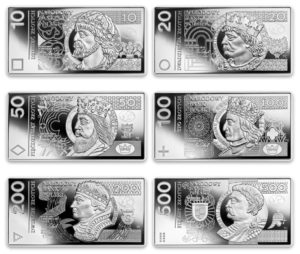
Do 31 grudnia 1994 r. wszyscy byliśmy „milionerami”, bo ceny i pensje wyrażane były nominalnie w milionach złotych. Dzień później nastąpiła denominacja złotego. 1 stycznia 1995 r. banknot o nominale 10 tys. zł zmienił się w monetę 1-złotową, a 1 mln oznaczał 100 nowych zł. Wartości nabrał nawet grosz. W 1995 r. do obiegu weszły banknoty o nominałach 10 zł, 20 zł, 50 zł, 100 zł oraz 200 zł, natomiast banknot o nominale 500 zł został wprowadzo – ny do obiegu w 2017 r. Projektantem nowej serii z wizerunkami władców Polski był – tradycyjnie – Andrzej Heidrich, „król polskich banknotów”. Andrzej Heidrich (1928–2019) współpracę z Narodowym Bankiem Polskim rozpoczął w 1960 r. Przez lata na zlecenie NBP wykonał dziesiątki szkiców i projektów banknotów, jednak dopiero w 1975 r. do obiegu wprowadzo – ny został jego pierwszy, ulubiony zresztą, banknot – 500 zł z Tadeuszem Kościuszką. Andrzej Heidrich zaprojektował serie banknotów „Wielcy Po – lacy” (funkcjonującą do 1996 r.) oraz „Władcy polscy” (w obiegu od 1995 r. do dzisiaj). Stylizowane wizerunki banknotów będących obecnie w obiegu – o nomi – nałach 10 zł, 20 zł, 50 zł, 100 zł, 200 zł oraz 500 zł – zostały zaprezentowa – ne na monetach kolekcjonerskich wchodzących w skład zestawu „Polskie banknoty obiegowe”. Informacja: prof. Jan Żaryn.

Banknotes in Circulation in Poland
www.nbp.pl
Issuing collector items is an occasion to commemorate important historic figures and anniversaries, as well as to develop the interest of the public in Polish culture, science and tradition. All Polish collector coins feature: face value, image of the Eagle established as the state emblem of the Republic of Poland, inscription: Rzeczpospolita Polska, year of issue. On 21 June 2022, Narodowy Bank Polski issued into circulation silver coins of the face values of 10 zł, 20 zł, 50 zł, 100 zł, 200 zł and 500 zł, that makes up a set of coins called “Banknotes in Circulation in Poland”.

Parameters of the coins in the set: Metal: Ag 999/1000; Finish: proof; Dimensions: 50.00 x 25.00 mm; Weight: 31.10 g; Edge (side): plain; Mintage: up to 3,000 pcs; Designer of the graphic images: Robert Kotowicz; Issuer: NBP; The coins, commissioned by NBP, were struck by Mennica Polska S.A.

We had all been millionaires until 31 December 1994, as prices and wages were nominally expressed in millions of zlotys. A day later a redenomination of the Polish złoty was carried out. On 1 January 1995, a banknote of a face value of 10,000 złoty turned into a 1 złoty coin, and 1,000,000 złoty was a 100 new złoty. Even a grosz gained in value. In 1995, banknotes of the denominations of 10 zł, 20 zł, 50 zł, 100 zł and 200 zł were put into circulation, whereas a 500 złoty banknote was introduced into circulation in 2017. By tradition, the new series with the images of Polish rulers on banknotes was designed by Andrzej Heidrich, the “king of Polish banknotes”. Andrzej Heidrich (1928–2019) began to collaborate with Narodowy Bank Polski in 1960. Over the years, he was commissioned by NBP to make dozens of banknote drawings and designs, however only in 1975 the banknote designed by him was put into circulation. It was a 500 złoty note depicting Tadeusz Kościuszko – the designer’s favourite banknote. Andrzej Heidrich designed the banknote series called “The Great Poles” (in circulation until 1996) and “The Polish Rulers” (in circulation from 1995 till the present day). The stylised images of banknotes which are currently in circulation – of the face values of 10 zł, 20 zł, 50 zł, 100 zł, 200 zł and 500 zł – are presented on collector coins that make up a set of coins called “Banknotes in Circu – lation in Poland”. Info: Prof. Jan Żaryn.


Endangered Whales: PermanentTM domestic rate stamps
www.canadapost.ca
This booklet of 10 PermanentTM domestic rate stamps, illustrated by David Miller, features five species of whales with populations assessed as Endangered in Canadian waters. This stamp issue features illustrations by David Miller that capture the grace and beauty of these five magnificent mammals swimming past an unseen lens in their underwater environment. The booklet features a reverse close-up of the illustration on the killer whale stamp, with a modified background. Graceful and intelligent, whales are magnificent marine mammals. This stamp issue celebrates the remarkable beauty and diversity of whales found in Canadian waters. It also raises awareness of the plight of five species – the blue whale, beluga whale, killer whale, northern bottlenose whale and North Atlantic right whale – that have populations assessed as Endangered by the Committee on the Status of Wildlife in Canada (COSEWIC).
Canada Post has a longstanding tradition of showcasing Canadian wildlife and using stamps to raise awareness of the impacts of human activity on fragile animal populations. Some populations of these species have been assessed as Endangered by the Committee on the Status of Endangered Wildlife in Canada (COSEWIC). Threats vary but include chemical and biological contaminants, stresses caused by noise and physical disturbances, collisions with vessels, entanglement in fishing gear and debris, reduced availability of food, hunting and the impacts of climate change. Stamp Designer: Soapbox Design; Stamp Illustrator: David Miller; Stamp Value: Permanent™ domestic rate; Quantity Produced: 250,000; Issue Date: May 20, 2022.
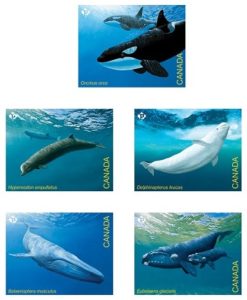
***The blue whale (Balaenoptera musculus), at up to 30 metres long, is the largest animal on Earth. The species faces a fragile future in both its Atlantic and Pacific populations.
***The beluga whale (Delphinapterus leucas) is well adapted to swimming under ice because it lacks a dorsal fin. It is at risk in the St. Lawrence Estuary, Cumberland Sound and Ungava Bay.
***The killer whale (Orcinus orca) is a highly social animal that lives in family-based pods. This species is seeing a steady decline in its southern resident population in the Northeast Pacific.
***The northern bottlenose whale (Hyperoodon ampullatus) is curious by nature. There are only an estimated 164 remaining on the Scotian Shelf, one of its deep-water habitats in the North Atlantic.
***The North Atlantic right whale (Eubalaena glacialis) is named for once being an easy and profitable target for hunters. It is disappearing so rapidly that it could soon be extinct, with an estimated 350 individuals remaining worldwide.

This souvenir sheet features the five stamps from the Endangered Whales issue, illustrated by David Miller that capture the grace and beauty of these five magnificent mammals swimming past an unseen lens in their underwater environment. Quantity Produced: 75,000; Issue Date: May 20, 2022.
This Official First Day Cover for the Endangered Whales stamp issue features an underwater illustration by David Miller and a green background that ties into the designs of the stamp issue’s uncut press sheet and booklet. Cancellation Site: Halifax, NS. Quantity Produced: 7,000; Issue Date: May 20, 2022.


Vintage Travel Posters: PermanentTM domestic rate stamps
www.canadapost.ca
This booklet of 10 PermanentTM domestic rate stamps features five travel posters that were designed to promote Canada as a tourist destination in the early 20th century. These bold, colourful posters represent a golden age of commercial art in Canada. They evoke feelings of nostalgia for a simpler time and stir the spirit of exploration. The front and inside covers of this three-panel booklet feature images from two of the posters: Canada’s Picturesque East Coast and Travel The Canadian. The inside of the booklet features a silhouette image of travellers at a train station by illustrator Gerard DuBois.
Canada’s popularity as a tourist destination surged in the early 20th century. Travel companies beckoned visitors to explore Canada’s wild beauty and urban attractions – promising world-class adventure, scenery and luxury. Talented artists and designers were commissioned to create eye-catching posters aimed at globe-trotting tourists and Canadians alike. This boom in travel advertisements, notable for their distinctive and elegant style, fostered a golden age of commercial art in Canada. This beautiful stamp issue features five iconic travel poster reproductions. Stamp Designer: Paprika; Stamp Value: Permanent™ domestic rate; Quantity Produced: 250,000; Issue Date: June 9, 2022.
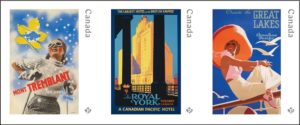
These posters promoted five well-known destinations across Canada:
***Travel The Canadian, by Roger Couillard, 1955
***Cruise the Great Lakes, after the work of Tom Purvis, circa 1937
***The Royal York, by Norman Fraser, circa 1935
***Mont Tremblant, by Herbert Bayer, 1939
***Canada’s Picturesque East Coast, by Peter Ewart, circa 1950.
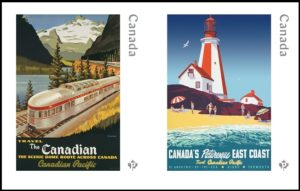
June 9, 2022 is the cancellation date for the issue as it marks the start of CAPEX 22 – the world’s first international one-frame stamp championship – which will be held at the Metro Toronto Convention Centre from June 9 to 12. The cancellation site – Toronto ON – was chosen because of its relevance to the poster advertising the Royal York hotel and because it is also the location of CAPEX 22. The cancellation mark is a line drawing of a vintage suitcase decorated with travel stickers.
Travel The Canadian, by Roger Couillard, 1955 … This poster depicts The Canadian, Canadian Pacific’s famous transcontinental train, which began service between Vancouver and Toronto/Montréal in 1955. It was Canada’s first passenger train to glass-domed observation cars, offering spectacular views.
Cruise the Great Lakes, after the work of Tom Purvis, circa 1937 … Created for Canadian Pacific, this poster promotes the breezy glamour of pleasure cruising on the Great Lakes. In the early 20th century, companies such as Canadian Pacific began to offer multi-day pleasure cruises as a way for vacationers to both relax and visit multiple destinations along the route.
The Royal York, by Norman Fraser, circa 1935 … This poster was commissioned to advertise the Royal York (now the Fairmont Royal York), the stately Canadian Pacific hotel that opened in downtown Toronto in June 1929. Shown here from the vantage point of Union Station, the 28-storey hotel was the tallest building in the city and the largest hotel in the British Empire at the time.
Mont Tremblant, by Herbert Bayer, 1939 … This poster was commissioned to promote the glamour and excitement of skiing at the newly opened Mont-Tremblant resort, in Quebec. American explorer and entrepreneur Joseph Bondurant Ryan saw the potential for the resort after climbing the mountain in 1937, and opened it two years later.
Canada’s Picturesque East Coast, by Peter Ewart, circa 1950 … This poster was commissioned by the CPR to promote travel to the east coast, highlighting three seaside CPR resort destinations: St. Andrews by-the-Sea, New Brunswick; Digby, Nova Scotia; and Yarmouth, Nova Scotia (whose original Cape Forchu lighthouse tower is featured on the poster, superimposed on a sandy beach). St. Andrews (marketed as St. Andrews-by-the-Sea) became a resort town in the late 1800s and by the 1930s was a popular destination. The CPR rebuilt Digby’s The Pines in the late 1920s/early 1930s and constructed an 18-hole golf course. Located on the southern tip of Nova Scotia, Yarmouth attracted visitors travelling by steamship from the northeastern United States.
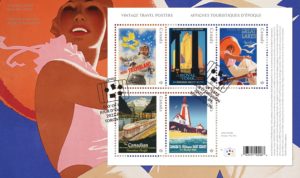
The Official First Day Cover (OFDC) for the Vintage Travel Posters stamp issue from Canada Post which features 5 iconic travel posters from the early 20th century. The front of the OFDC features a close-up of a traveller depicted on the Cruise the Great Lakes poster. Cancellation Site: Toronto ON; Stamp Designer: Paprika; Stamp Value: Permanent™ domestic rate; Quantity Produced 7,000; Issue Date: June 9, 2022.
The souvenir sheet features the five stamps from the Vintage Travel Posters stamp issue from Canada Post. The stamps in this issue are reproductions of five travel posters that were created to promote Canada as a tourist destination in the early 20th century. These bold, colourful posters represent a golden age of commercial art in Canada. They evoke feelings of nostalgia for a simpler time and stir the spirit of exploration. Stamp Designer: Paprika; Quantity Produced: 60,000; Issue Date: June 9, 2022.

Pure Gold Coin – Earth Dragon
www.mint.ca
Celebrate Chinese New Year with an auspicious golden dragon! According to Chinese mythology, Dilong is the Earth Dragon or Underground Dragon that rules over rivers and streams, and on this 99.99% pure gold coin, the Earth Dragon keeps a watchful eye over Canada’s waterways. While its features imply great strength and courage, this dragon also holds the yin-yang symbol that represents unity, balance and harmony. May this Earth Dragon give you strength and help bring balance into your life.
Your lucky gold dragon for 2022 … The dragon is one of the most popular and powerful figures in Chinese mythology—it is the king of all animals. This coin’s design represents the spirit of a dragon and features Dilong, the Earth Dragon and protector of waterways. A special wish … The yin-yang symbol adds an extra layer of meaning to the design. It is an elegant way to communicate a hope for harmony, balance and peace in the life of the coin’s recipient. Red box … In keeping with the “red envelope” gift-giving tradition, your gold dragon coin comes packaged in a special beauty box that features the colour red to attract good luck.
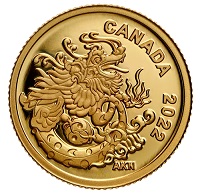
Face value: 8 dollars … Composition: 99.99% pure gold;
Mintage: 8,888; Finish: Proof; Weight: 1.58g;
Diameter: 14.1 mm; Edge: serrated; Certificate: serialized;
Artist: Albert Ng (reverse), Susanna Blunt (obverse).
Did You Know? … ***If you look closely, you’ll notice this dragon is covered in scales. This feature implies strength and valour, but it also alludes to the vegetation that grows along the edges of waterways.
Designed by graphic designer Albert Ng, your coin’s reverse is inspired by ancient Chinese mythology and features Dilong, the Earth Dragon. This traditional protector of waterways stands dignified and proud, with features that imply valour and strength; its sharp claws grip a yin-yang symbol that represents unity, balance and harmony. The obverse features the effigy of Her Majesty Queen Elizabeth II by Susanna Blunt.

2022 … Silver One-Cent Coin –
Farewell to the Penny: W Mint Mark
www.mint.ca
It was 10 years ago, in 2012, that the last Canadian penny was struck at our Winnipeg facility. Now, a decade later, the cent’s maple leaf twig design has been brought out of retirement for a limited appearance on this 99.99% pure silver tribute. Struck in a tailored specimen finish, the maple leaves feature a soft satin finish, while the field is filled with angled lines that meet at the centre. Those lines are a nod to our pyramid-shaped Winnipeg facility where this “W” mint mark coin was struck, and where all our pennies were minted between 1976 and 2012. Gone but not forgotten! Relive your memories of the penny with this “struck in Winnipeg” tribute.
“W” mint mark … Like all pennies issued between 1976 and 2012, this 10th Anniversary tribute was struck at our Winnipeg facility. But unlike all pennies, this collectible proudly bears a “W” (Winnipeg) mint mark that indicates where it was made—it’s the only new addition to the classic design. A tailored specimen finish … You’ve never seen the penny quite like this. Thanks to a tailored specimen finish, G. E. Kruger Gray’s timeless maple leaves feature a pleasing satin sheen, while the field is filled with angled lines that meet at the centre to form pyramids—a nod to our pyramid-shaped Winnipeg facility!
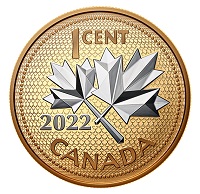
Face value: 1 cent … Composition: 99.99% pure silver;
Mintage: 15,000; Finish: Tailored Specimen; Weight: 31.39g;
Diameter: 38 mm; Edge: serrated; Certificate: serialized;
Artist: G. E. Kruger Gray (reverse), Susanna Blunt (obverse).
Did You Know? … ***Unlike the other denominations of Canadian circulation coinage, the one-cent coin rarely featured any other design than the one introduced in 1937 (and featured on this coin). The only exception was in 1967, when a rock dove design by Alex Colville temporarily replaced the maple twig to mark the 100ᵗʰ anniversary of Confederation. ***The penny was one of the first “struck in Canada” coins. Two coins were minted during the official opening of our Ottawa facility on January 2, 1908: a 50-cent coin struck by Governor General Early Grey, and a bronze cent struck by his wife, Countess Grey.
Struck in a tailored specimen finish (satin relief against a pyramidal line pattern), your coin’s reverse is a reproduction of the beloved one-cent circulation design by G. E. Kruger Gray. It features two maple leaves on the same twig, as seen on most Canadian pennies issued between 1937 and 2012. The reverse also features a “W” Mint mark signifying the coin was proudly struck at our facility in Winnipeg, Manitoba. The obverse features the effigy of Her Majesty Queen Elizabeth II by Susanna Blunt.

2022 … Fine Silver Coin – The Mighty Bison
www.mint.ca
A grassland icon stands tall in this superbly engraved wildlife portrait, which captures the majesty of the species and its historic habitat. An inspiring emblem of strength, the plains bison (Bison bison bison) that once dominated the vast Canadian prairie continues to be a species of great historical and cultural importance in Canada. It never fails to capture our imaginations through its imposing stature and innate strength, as conveyed by the two bulls featured in this 2 oz. 99.99% pure silver portrait. A classic portrait with classically engraved details—it’s a true testament to fine craftsmanship and artistry. A mix of frostings … On your coin’s reverse, multiple frostings add a sense of depth and create a striking contrast between the different design elements, resulting in a more realistic portrait of the bison and its environment.

Face value: 30 dollars … Composition: 99.99% pure silver;
Mintage: 4,500; Finish: Proof; Weight: 62.69g;
Diameter: 50 mm; Edge: serrated;
Artist: Claudio D’Angelo (reverse), Susanna Blunt (obverse).
Packaging: Black clamshell with black beauty box.
Did You Know? *** Is it “buffalo” or “bison”? Those terms are often used interchangeably, but scientifically speaking, they’re two different species: bison are indigenous to North America and Europe, while buffalo are found in Africa (cape buffalo) and Asia (water buffalo). *** Two subspecies are found in Canada: the plains bison and the wood bison. The wood bison is heavier and has a more distinctive shoulder hump, while the plains bison is lighter in colour and has a stockier build.
Designed by Canadian wildlife artist Claudio D’Angelo, your coin’s reverse features a side-view portrait of two plains bison (Bison bison bison) in its grassland habitat during the harsh winter months. Two males (members of a bachelor group) are positioned in a way that best showcases their physical features, with one bull standing at the top of a knoll and the other below facing the opposite direction. The obverse features a field pattern and the effigy of Her Majesty Queen Elizabeth II by Susanna Blunt.
Claudio D’Angelo, Artist … “While sketching out various design possibilities, I came up with the idea of a bison bull walking up a mound, with a second one walking in the opposite direction below, effectively creating a clockwise motion. It allowed me to illustrate both animals in their entirety, while also keeping with a round format. Years ago, I had the good fortune of observing bison in the wild, and I was struck by the imposing stature and domineering nature of the bulls. I had no doubt that these were not animals to be trifled with, and that memory fueled my desire to evoke as much of their inherent grandeur as possible.”
Eric Boyer, 3D Artist and Engraver … “No-tech coins are like coming home for an engraver: they’re familiar, even rejuvenating. It’s a joy to sculpt a natural, organic scene with a striking composition. And a layout like this one, where the focus is nicely centred, allows me to use the maximum relief height assigned by Engineering to realize the full form and weight of these majestic animals.”


$200 … Pure Gold Coin – Celebrating Canada’s Diversity:
Culture and Traditions
www.mint.ca
Music, dancing, art, food and storytelling—French-Canadian traditions are many and varied, but they all have one thing in common: they make Canada’s cultural mosaic more distinct, vibrant and exciting! The sparkling blue sapphire on this 99.99% pure gold coin serves as a vibrant representation of the Francophone spirit that has always been a cornerstone of our nation. And on this coin’s reverse, the magnificent blue gemstone is surrounded by some of the many diverse symbols that are proudly associated with French heritage in Canada. Designed to captivate … Crafted in 99.99% pure gold, this 1 oz. coin features a highly intricate design on its reverse, where the engraved arrangement is a proud celebration of Canada’s rich cultural diversity. A stunning sapphire … Your coin features a grade AAA natural blue sapphire. The 0.75 carat rose-cut gemstone adds a captivating colour to this design while representing Canada’s Francophone spirit. A symbolic arrangement … Canada’s Francophone communities use diverse emblems to express their identity and pride, and some of those symbols have been combined on your coin’s reverse, where the iconic ceinture fléchée wraps around and embraces them as a whole.
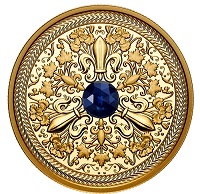
Face value: 200 dollars … Composition: 99.99% pure gold
with genuine grade AAA 0.75 carat rose-cut blue
sapphire EmbellishmentsGems;
Mintage: 275; Finish: Proof; Weight: 31.16g;
Diameter: 30 mm; Edge: serrated;
Artist: Hélène Girard (reverse), Susanna Blunt (obverse).
Did You Know? … *** Sapphires come in a variety of colours ranging from violet to orange, and even brown or black. As a type of corundum, sapphire is one of the world’s hardest minerals, second only to diamonds! *** New Brunswick is Canada’s only officially bilingual province, and that’s why its provincial flower (the purple violet) appears alongside Quebec’s provincial flower (the blue flag iris) on this coin’s reverse. *** While the majority of French-Canadians live in Quebec, you’ll find proud Francophone communities all across Canada, with Franco-Ontarians forming the largest community (744,000) outside of Quebec. With approximately 500,000 Acadians in Canada, many reside in the Maritime provinces of New Brunswick, Nova Scotia and Prince Edward Island. *** While there is some debate about the exact origins of the ceinture fléchée, French-Canadian, Indigenous and Métis communities all share the arrow sash as a key cultural symbol. After 1835, sashes produced in Canada primarily came from the region of Assomption, Quebec; known as the Assomption sash, its standard design—herringbone stitching with red, blue and white colours—makes it instantly recognizable.
The reverse design by Canadian artist Hélène Girard features a grade AAA rose cut blue sapphire at its centre, where the gemstone’s blue hue represents Canada’s Francophone spirit. The gemstone is surrounded by an engraved arrangement of repeating ornamental flourishes and emblems associated with French heritage in Canada, including: the fleur-de-lis, a symbol that evokes the wider French-speaking community; the blue flag iris, the floral emblem of Quebec; the purple violet, the floral emblem of New Brunswick; and maple leaves that represent all Francophone communities in Canada. The iconic ceinture fléchée (arrow sash) surrounds the design, embracing all the individual elements as a whole. The obverse features the effigy of Her Majesty Queen Elizabeth II by Susanna Blunt.
Hélène Girard, artist … “As a Francophone artist who is part of Canada’s diversity, I was honoured to work on the design of this coin to celebrate French Canadians. I wanted to incorporate the ceinture fléchée (arrow sash), which is part of our culture’s traditional costumes, and the floral emblems of Quebec and New Brunswick. The delicateness of my subjects, that truly express the beauty of this culture, has helped me realize my goal.” Cecily Mok, Engraver … “The challenge here was to ensure all the individual elements formed a unified whole. Some of the elements were sculpted with minimal thickness to ensure fluid lines and a smooth transition from one point of interest to another. We also added tiny flourishes to the large fleurs-de-lis, as a way of enhancing the relief when viewed from different angles.”


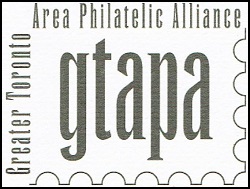
www.gtapa.org
The GTAPA is committed to promote and stimulate
the art of philately to all ages for fun,
culture, education, and friendship.


